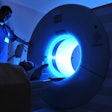
Aortic valve replacement may be more accurate when measurements are made with CT versus echocardiography, according to a January 24 paper in Academic Radiology. Coronary CT angiography (CCTA) measurements correlated well with 3D echocardiography results by most measures, making CT a suitable replacement for echo in planning transcatheter aortic valve replacement (TAVR) surgery.
The study of 74 patients compared CCTA with 3D transesophageal echocardiography (3D-TEE) TAVR planning, and the researchers also evaluated the use of semiautomated software for CCTA annular measurements. They found that CCTA measurements were highly correlated with measurements by 3D-TEE -- with the wrinkle that diastolic CCTA measurements were actually closer to midsystolic 3D-TEE.
"We found that the diastolic-phase measurements that we obtained from CCTA were generally closer to the measurements that are obtained by 3D-TEE," corresponding author Dr. Ethan Halpern told AuntMinnie.com. "Several studies suggest that systolic-phase CCTA imaging may be more accurate. However, our study suggests that if we are following sizing criteria that are based on echocardiography, then it may make more sense to use diastolic-phase CCTA measurements."
Correlation was just as good between measurements of annular diameter and area performed by a first-year radiology resident using semiautomated TAVR software and those performed manually by a senior cardiothoracic radiologist. Even so, the variation between automated and manual measurements in individual cases could potentially result in the selection of a different-sized prosthesis, wrote Dr. David Guez, Dr. Gilda Boroumand, Halpern, and colleagues from Thomas Jefferson University (Acad Radiol, January 24, 2017).
Sizing is key
As transcatheter aortic valve replacement has become an established nonsurgical treatment option for severe aortic stenosis, radiologists have an important role in choosing the appropriately sized prosthesis to ensure success. A prosthesis that is too small for the annulus can lead to paravalvular aortic regurgitation, device migration, or even valve embolization, the authors wrote.
But a valve that is too large "can result in decreased durability of the valve due to unequal tensile forces, or even annular rupture -- a complication that can prove fatal," they wrote.
Because accurate positioning is also critical for valve stability and function, imaging guidance is essential for prosthesis selection and accurate placement within the left-ventricular outflow tract.
Previous studies have suggested that sizing the prosthesis during systole is preferable to diastole to minimize the risk of aortic regurgitation. At Thomas Jefferson University, ECG-gated CCTA is acquired before the procedure and 3D-TEE is performed in real-time during the procedure.
"Our study aimed to examine how well the measurements of various 3D imaging modalities are correlated, including manual measurements of the annular diameter and area with ECG-gated CCTA, semiautomated CCTA measurements performed by the transcatheter aortic valve implantation (TAVI) semiautomated software, and 3D-TEE," the authors wrote.
The cohort of 74 patients underwent both 3D-TEE and ECG-gated CCTA within 30 days for TAVR planning. Measurements for 3D-TEE were obtained during midsystole, while CCTA measurements were obtained during late systole, as follows:
- CT was performed using a 256-detector-row iCT scanner (Philips Healthcare) during IV injection of iodinated contrast. Images were acquired using retrospective ECG gating at 100 kVp, with a tube current of 600 mAs to 100 mAs depending on patient weight.
- Images were analyzed manually on a 3D Brilliance workstation (Philips) by an experienced cardiothoracic radiologist, who obtained maximum and minimum diameters and annular area measurements at end-systole and middiastole.
- A first-year radiology resident blinded to CCTA results used TAVI semiautomated software (IntelliSpace Portal, Philips) to make the same measurements after training on five sample cases.
- The software automatically selected the plane of the virtual aortic annulus, which was then checked by the resident. The software also automatically delineated the perimeter of the aortic annulus, and TEE was performed on an echocardiography system (iE33, Philips) with a matrix-array probe allowing for both 2D and 3D echocardiographic imaging.
Highly correlated by most measures
Short- and long-axis diameters of the annulus as well as annular area by echo and CCTA were compared using Pearson correlation coefficients and paired t-tests. Bland-Altman analysis further characterized CCTA and TEE measurements.
The CCTA measurements in systole and diastole showed excellent correlation for short-axis diameter (r = 0.91), long-axis diameter (r = 0.92), and annular area (r = 0.96). However, systolic measurements were significantly larger (p < 0.001), especially in the short-axis diameter, the authors wrote. The results also showed good correlation between 3D-TEE and CCTA for short-axis diameter (r = 0.84-0.90), long-axis diameter (r = 0.77-0.79), and annular area (r = 0.89-0.90).
Compared with 3D-TEE, annular area was overmeasured by 28 mm2 for systolic-phase CCTA (p < 0.008), but it was nearly identical to 3D-TEE on diastolic-phase CCTA, the study team wrote. Semiautomated and manual CCTA annulus measurements were highly correlated in systole (r = 0.94) and diastole (r = 0.93), although the semiautomated annular area measured 11 mm2 to 30 mm2 greater than manual planimetry.
The best agreement between CCTA and 3D-TEE measurements of annular area is obtained when CCTA measurements are performed during middiastole, "even though 3D-TEE measurements are obtained during midsystole during maximum opening of the aortic valve," they wrote.
Despite the good correlation, Bland-Altman analysis showed 95% limits of agreement between CCTA and 3D-TEE in the range of ± 100 mm2 for annular area, with increasing variability as a function of mean annular area.
Applying the 95% limits of agreement to the size charts for prostheses showed that variability may be sufficient to select the wrong-sized aortic valve prosthesis. For this reason, it is important to visually inspect the annular contour derived from the software.
| CCTA and 3D-TEE measurements of the aortic annulus | |||||
| 3D-TEE | CCTA diastole | CCTA systole | |||
| Annular diameter minimum (mm) | 22.1 ± 0.4 | 21.5 ± 0.4 | 22.6 ± 0.4 | ||
| Annular diameter maximum (mm) | 26.5 ± 0.5 | 27.2 ± 0.4 | 27.9 ± 0.4 | ||
| Annular area (mm2) | 467 ± 15 | 466 ± 13 | 495 ± 14 | ||
Study limitations included potential measurement bias, and the lack of a gold standard for measurement of the annulus. In addition, prior studies suggest that increased precision of 3D measurements does not necessarily correlate with better outcomes, "leaving some confusion regarding the best approach to preprocedural imaging and prosthesis size selection," Halpern and colleagues wrote.
Physicians who perform the TAVR procedure should consider using diastolic-phase CCTA for sizing of the device, especially when CCTA measurements are used in conjunction with 3D-TEE. Semiautomated software-based CCTA measurements performed by a relatively inexperienced reader with focused training are highly correlated with CCTA measurements obtained by an experienced reader with manual planimetry, they wrote.
Most institutions have switched to CCTA from TEE for preoperative planning for TAVR, and several studies suggest that systolic-phase CCTA may be more accurate, Halpern said.
"However, our study suggests that if we are following sizing criteria that are based on echocardiography, then it may make more sense to use diastolic-phase CCTA measurements," he added. "We also noted a fair amount of variation in automated CCTA measurements of the aortic annulus, prompting us to warn clinicians that they need to carefully check the landmarks that are used by automated programs to measure the aortic annulus."



















